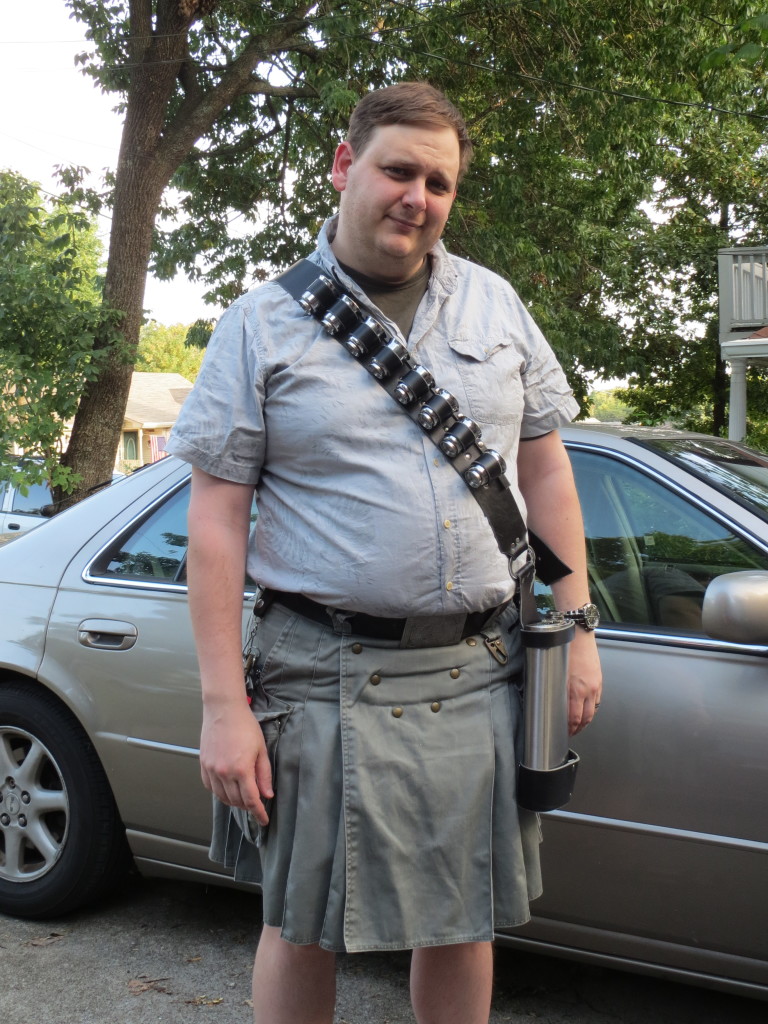Before I get into it, I want to remind people why I’m doing this. This month is Prostrate awareness month, and I’m participating in Kilted to Kick Cancer. Last year, we raised $13,000 for research, and want to beat that this year. If you’ve got some extra cash, please follow that link and tell them that Team Oddball sent you.
Wow… it’s almost the end of the week, and I forgot to post a picture (I blame Dragoncon), so… here you go!
I figured this year I’d discuss the basics of wearing kilts. This being the first post, I might as well start off with the simple stuff and discuss the different types.
There’s basically 3 types, starting from newest to oldest:
- The utility kilt: This is what I’m wearing above, made by one of the first companies to make them (Utilikilt). These are a new idea that basically didn’t exist until they and Alt.kilt came around in the early 2000’s. Now it seems like everyone’s making them. I’m sure everyone reading this blog is familiar with 5.11’s attempt at making them. I’d also point to UTKilt as a good manufacturer for cheap ones. There are some companies that have made them in various tartans, but, for the most part, you’re looking at solid colors. The biggest benefit these have over the more traditional styles is pockets.
- The small kilt: This is what most folks think of when you say “kilt,” and has been standard for formal events/uniforms/etc for a couple hundred years now. These are almost always made using fabric with a tartan/plaid pattern on it, but can be found with solid colors (or if some crazy person decides to make one out of hawaiian print fabric). Traditionally, they’re made of wool, but you can get them made out of acrylic, rayon, and various other fabrics. While some companies do offer some with hidden pockets (notably, Sportkilt), if you’re wanting to carry anything, it’s going to have to be stuffed in your sporran (that pouch in the front), or other pouches hanging off your belt. Oh, and if you’re not hanging things off your belt, the belt is purely for decoration, and many kilts of this type don’t have belt loops.
- The great kilt: The great kilt is the oldest of the types. It’s basically a large piece of fabric (typically wool) and a belt. The cloth is laid on the ground and pleated on top of the belt. The wearer then lays down on the cloth, wraps it around him, and then secures it with the belt. This garment serves multiple purposes as outerwear, a hooded cloak if needed, and a bed roll (a 60″ by 6-9yard piece of thick wool will keep you pretty warm, even on a cold damp night in the highlands). If you’re going to go this route, be warned that it is expensive. There’s no way to get around the price of that much fabric. Obviously, there are no pockets, although I’ve seen folks gather the excess fabric as makeshift pockets.
One last thing, the flat panel of the kilt should be facing forward, not the pleats. I would think that this is obvious, but I’ve seen folks on TV wearing the damn things backwards.

